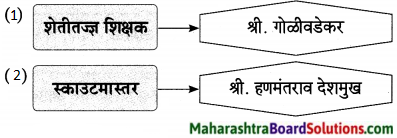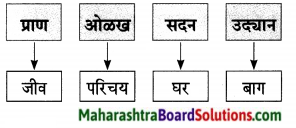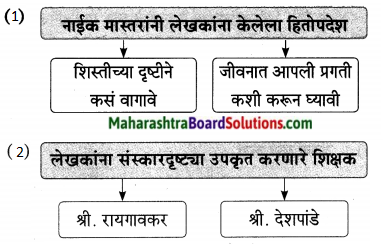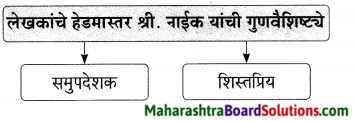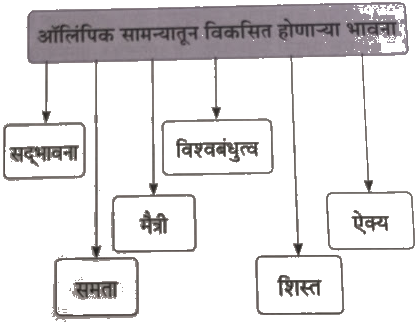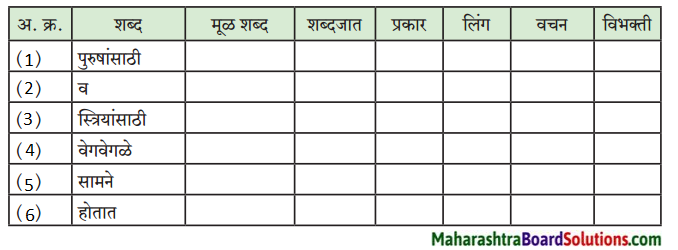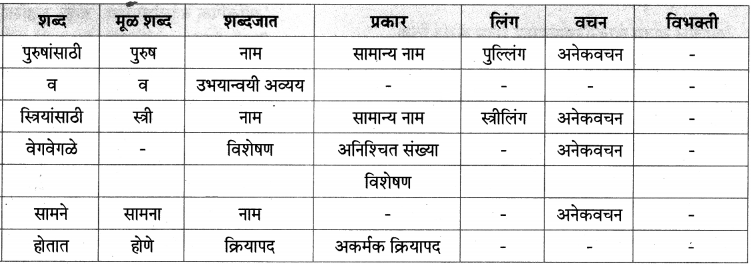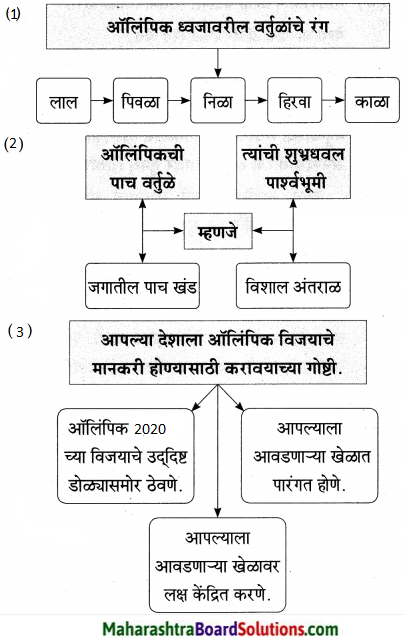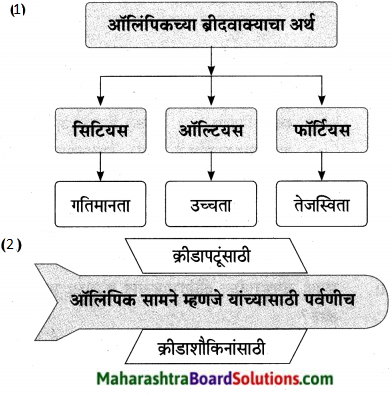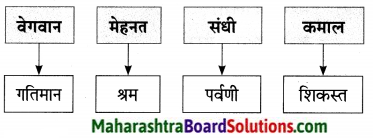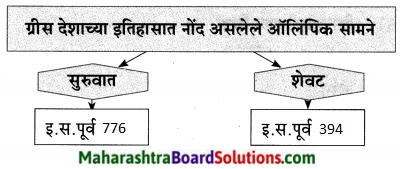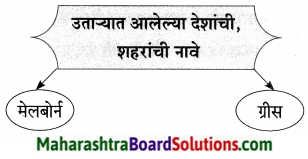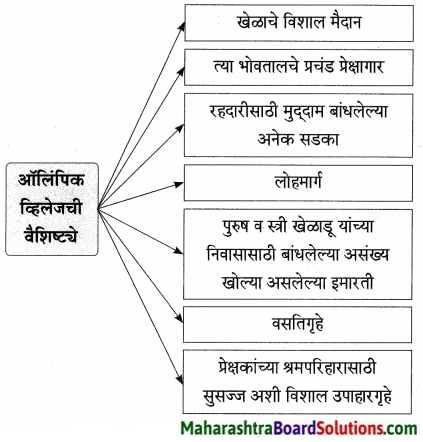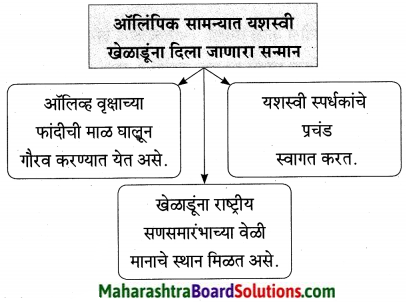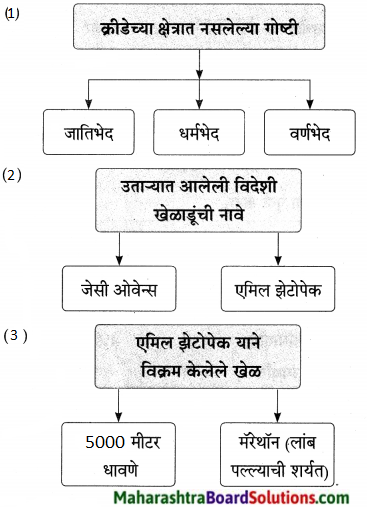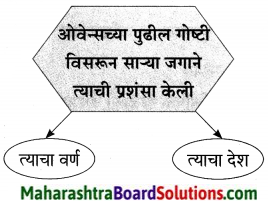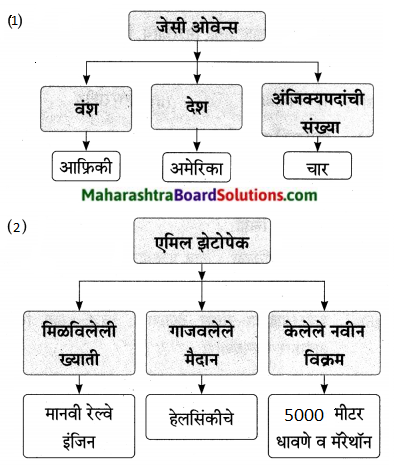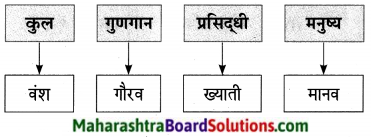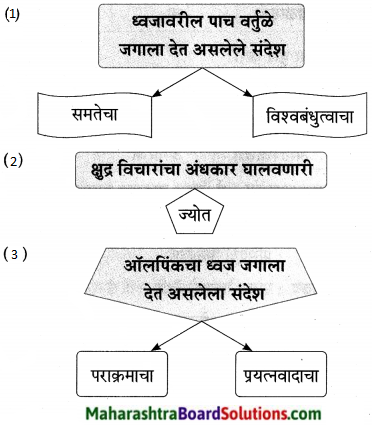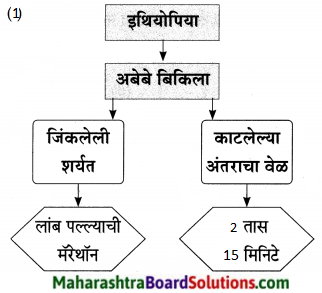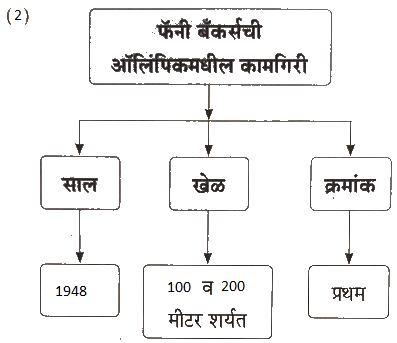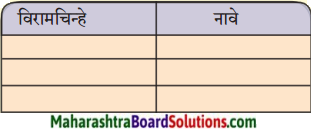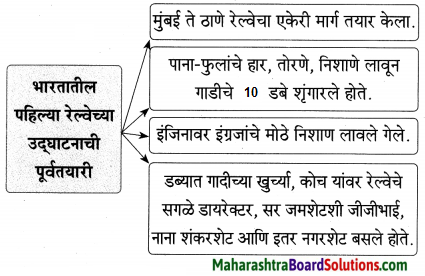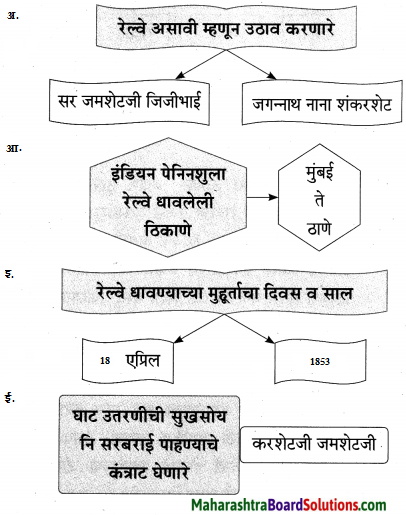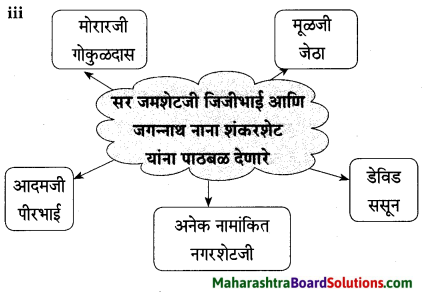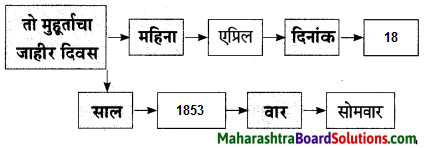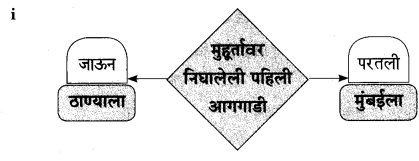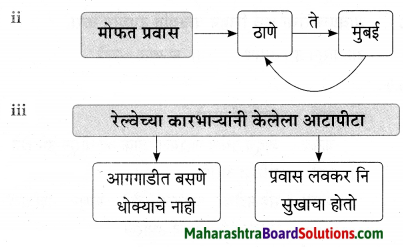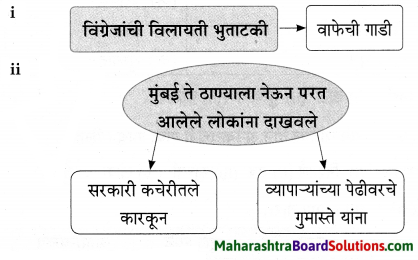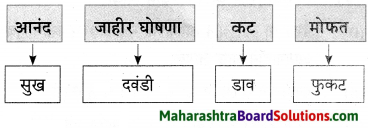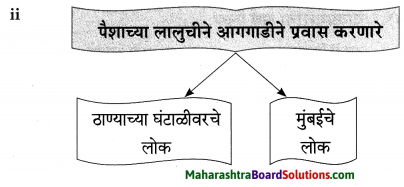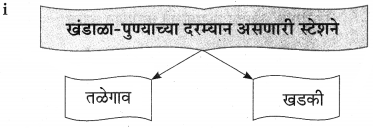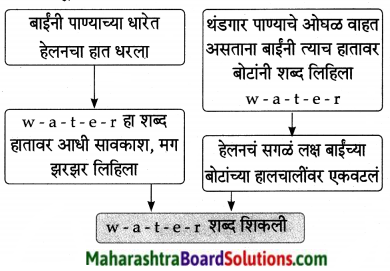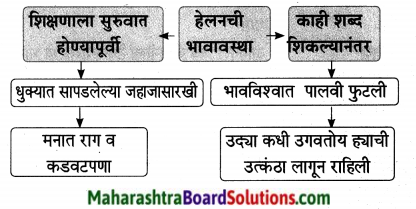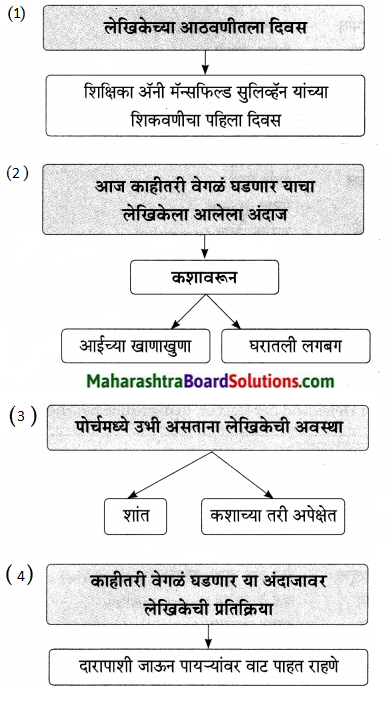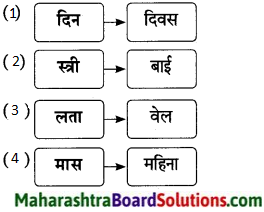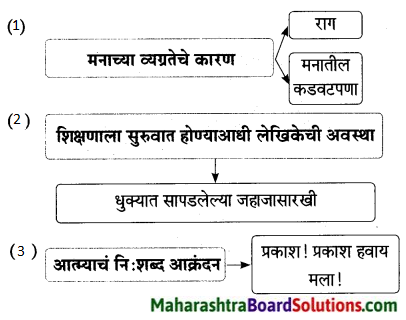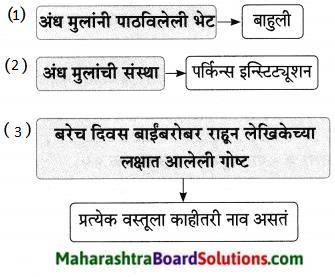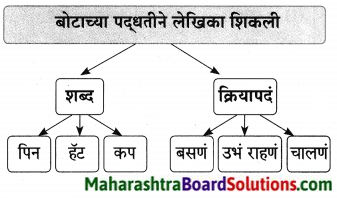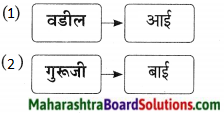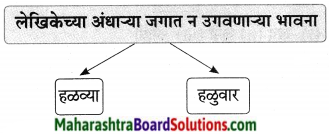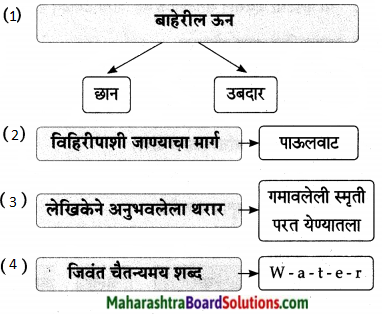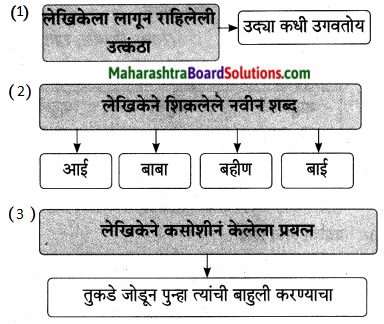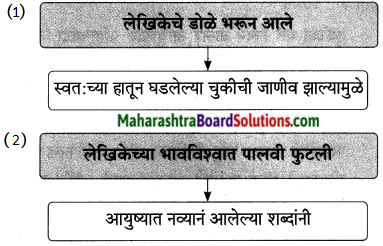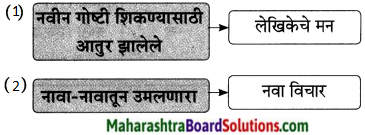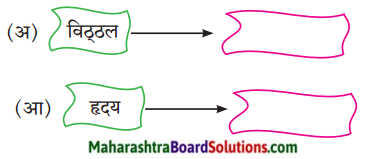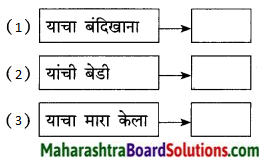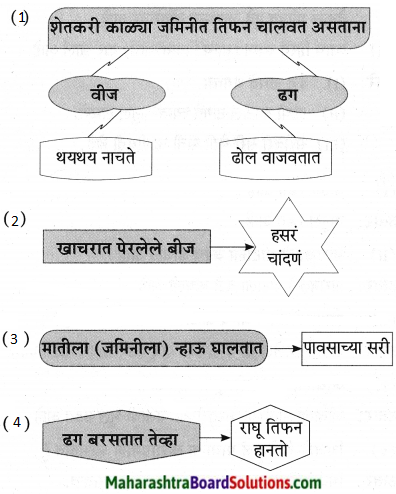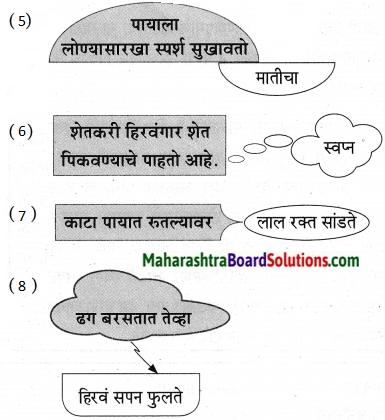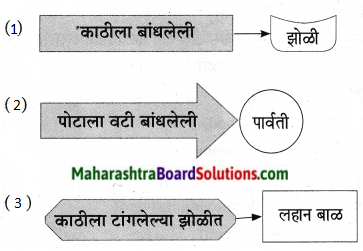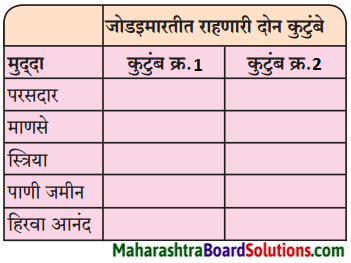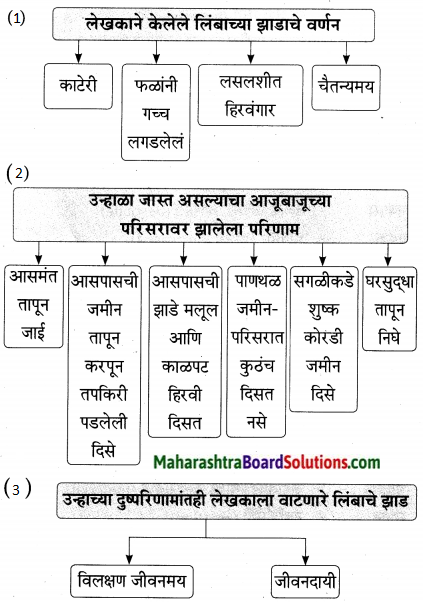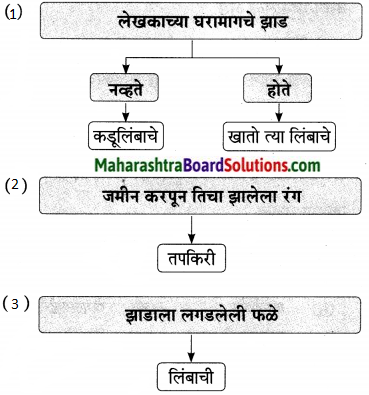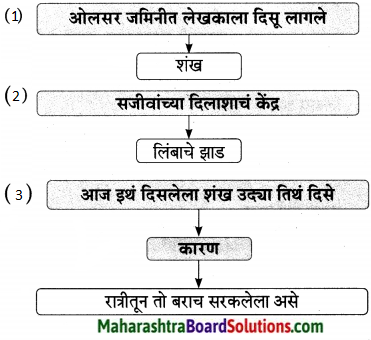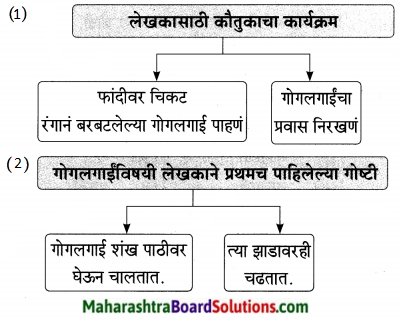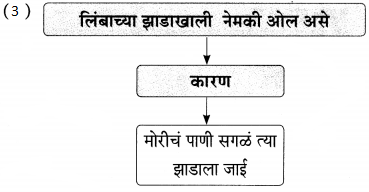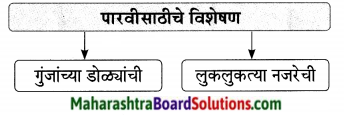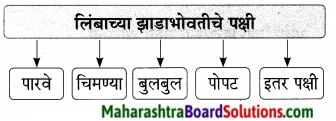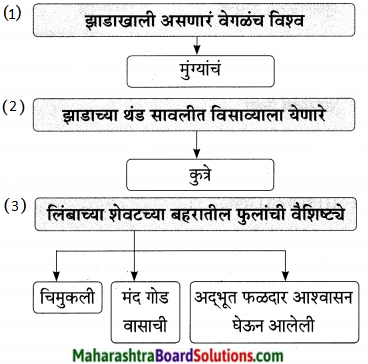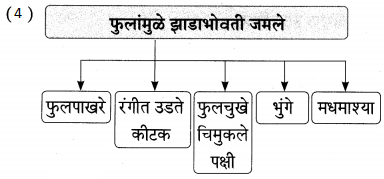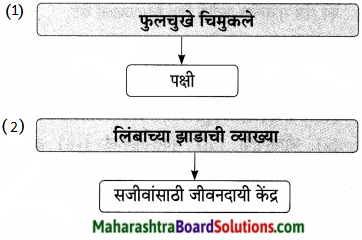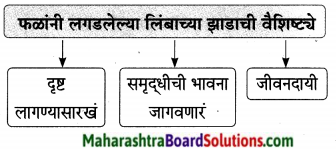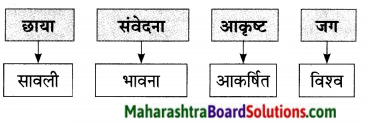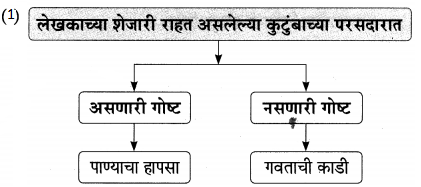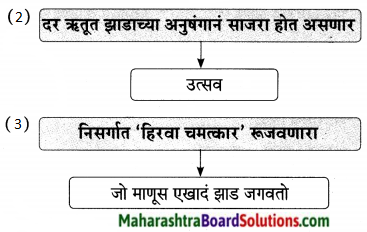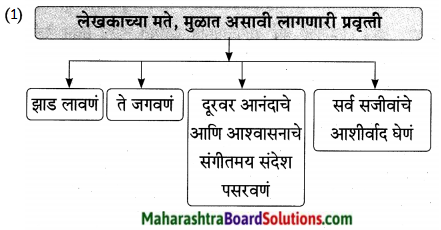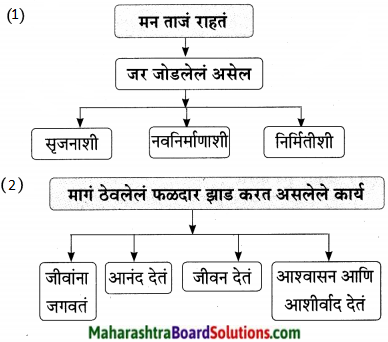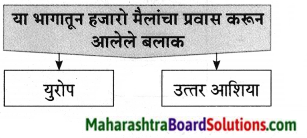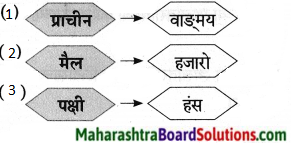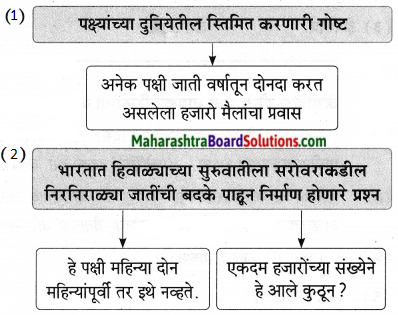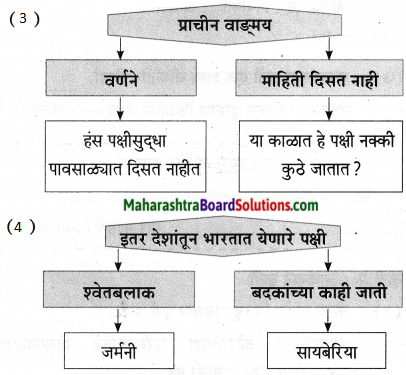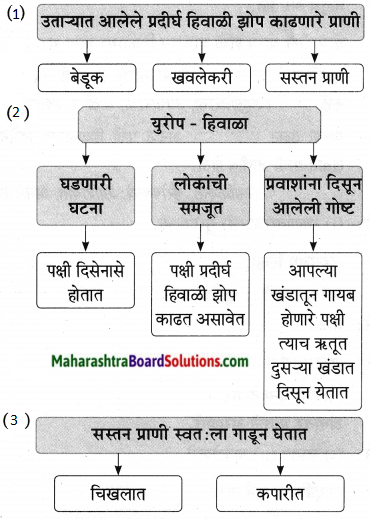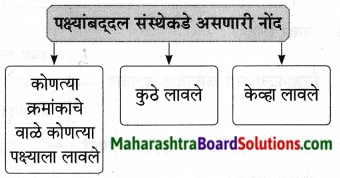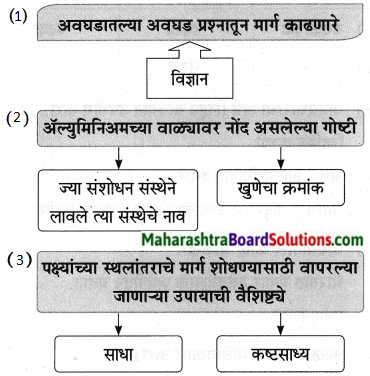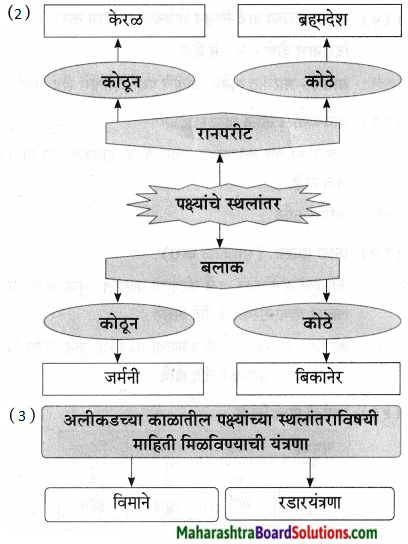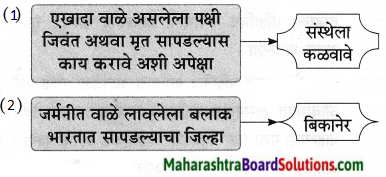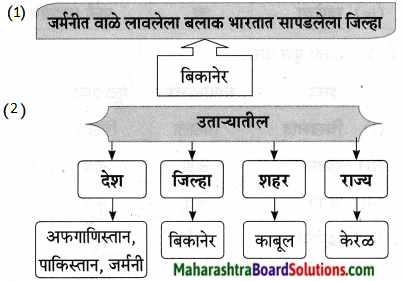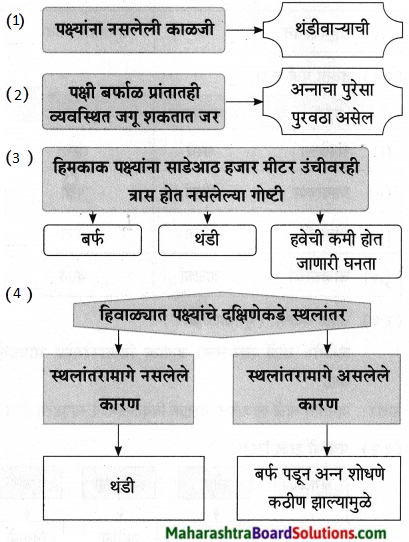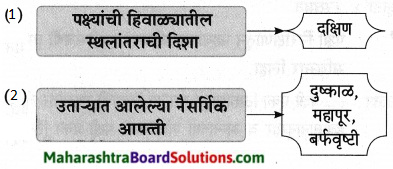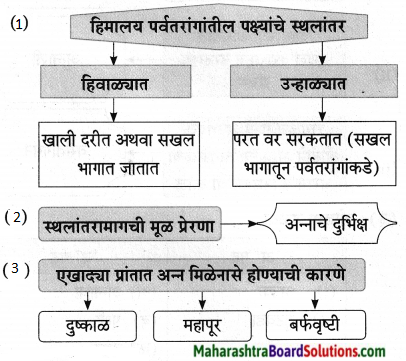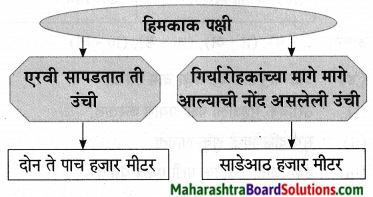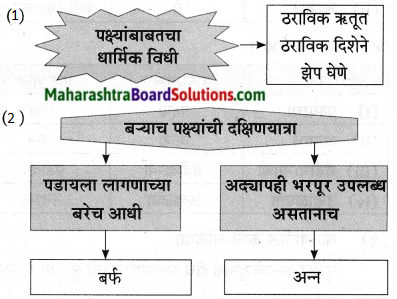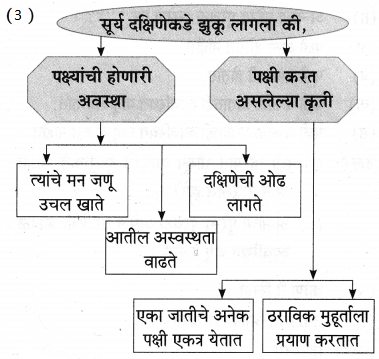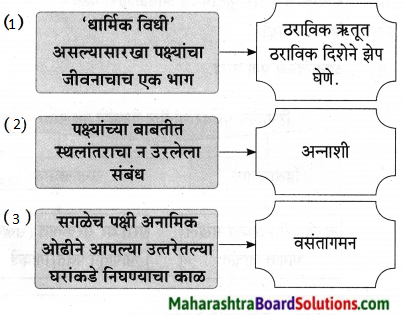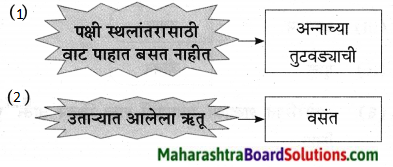Balbharti Maharashtra State Board Class 9 Marathi Solutions Aksharbharati Chapter 5 व्यायामाचे महत्त Notes, Textbook Exercise Important Questions and Answers.
Maharashtra State Board Class 9 Marathi Aksharbharati Solutions Chapter 5 व्यायामाचे महत्त(कविता)
Marathi Aksharbharati Std 9 Digest Chapter 5 व्यायामाचे महत्त Textbook Questions and Answers
1. व्यायामाचे फायदे दर्शवणारा आकृतिबंध पूर्ण करा.
प्रश्न 1.
व्यायामाचे फायदे दर्शवणारा आकृतिबंध पूर्ण करा.

उत्तर:
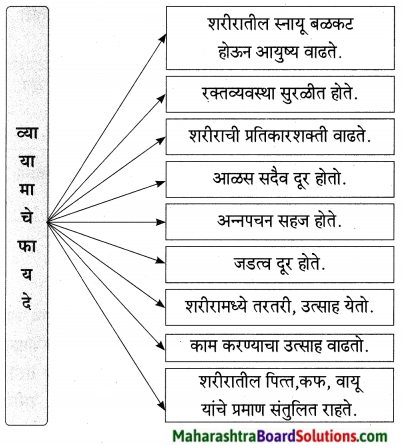
2. चूक की बरोबर ते लिहा.
प्रश्न 1.
चूक की बरोबर ते लिहा.
(अ) व्यायाम सर्वांकरता उपयुक्त असतो.
(आ) व्यायामाने जडत्व वाढते.
(इ) व्यायामाने स्नायू अशक्त होतात.
(ई) व्यायामाने प्रतिकारशक्ती वाढते.
उत्तर:
(अ) बरोबर
(आ) चूक
(इ) चूक
(ई) बरोबर
![]()
3. शब्दसमूहांबद्दल एक शब्द चौकटीत लिहा.
प्रश्न 1.
शब्दसमूहांबद्दल एक शब्द चौकटीत लिहा.
(अ) आरोग्य देणारी –
(आ) विरोध करण्याची क्षमता असलेली शक्ती –
(इ) स्वत:ची कामे स्वत:करणारा –
(ई) एका अंगाने केलेला विचार –
उत्तर:
(अ) आरोग्यदायी
(आ) प्रतिकारशक्ती
(इ) स्वावलंबी
(ई) एकांगी
4. व्यायाम न करण्याचे तोटे लिहून आकृती पूर्ण करा.
प्रश्न 1.
व्यायाम न करण्याचे तोटे लिहून आकृती पूर्ण करा.
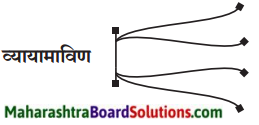
उत्तर:

5. भावार्थाधारित
प्रश्न (अ)
व्यायामाचे महत्त्व तुमच्या शब्दांत लिहा.
उत्तरः
मानवी जीवनात व्यायामाचे अनन्यसाधारण महत्त्व आहे. व्यायामाचे महत्त्व संपूर्ण जगाने मान्य केले आहे. व्यायामामुळे शरीरातील आळस, कंटाळा दूर होतो. शरीरामध्ये तरतरी, उत्साह येतो. व्यायामामुळे अन्नपचन सहजपणे होते. शरीरात स्थूलपणा वाढत नाही. रक्तव्यवस्था सुरळीत होते. शरीरातील स्नायू बळकट मजबूत होऊन आपले आयुष्य वाढते. शिवाय शरीरातील पित्त, कफ, वायू यांचे प्रमाण संतुलित राहण्यास मदत होते. त्यामुळे शरीराची प्रतिकारशक्ती वाढते आणि काम करण्याचा उत्साह वाढतो. त्यामुळे दररोज व्यायाम करणे आवश्यक आहे.
![]()
प्रश्न (आ)
‘व्यायामे अंगी वाढे स्फूर्ति। कार्य करण्याची।।’ या पंक्तीतील तुम्हांला समजलेला अर्थ लिहा.
उत्तरः
तुकडोजी महाराज म्हणतात की, व्यायामामुळे आपल्या शरीराला बळकटी प्राप्त होऊन रोग प्रतिकारकशक्ती वाढते. येणाऱ्या आजारांचा, संकटांचा आपण सहज सामना करू शकतो. त्याचबरोबर शरीर सुदृढ झाल्यामुळे आपण स्वावलंबीसुद्धा बनतो. आपल्या व्यक्तिगत कामासाठी आपल्याला दुसऱ्या कोणावर अवलंबून राहण्याची आवश्यकता राहत नाही. या नियमित व्यायामामुळे शरीरातील आळस कंटाळा दूर होऊन शरीर ताजेतवाने बनते. शिवाय कोणत्याही कामामध्ये उत्साह जाणवतो. म्हणजेच कोणतेही काम करण्याची शरीरातील जोश, स्फूर्ती वाढते.
प्रश्न (इ)
‘आरोग्यम् धनसंपदा’ या उक्तीतील विचाराचा विस्तार करा.
उत्तरः
संध्याकाळी दिवेलागणीच्या वेळी देवाजवळ बसून घराघरात ‘शुभं करोति कल्याणम्’ ही दिव्याची प्रार्थना म्हटली जाते. ‘आरोग्यम् धनसंपदा’ ही त्यातीलच एक पंक्ती आहे. प्रार्थना करताना जणू आपण परमेश्वराकडून आरोग्यरूपी धनसंपदेची अपेक्षा करत असतो. पण अवघ्या जगाने मान्य केले आहे की उत्तम आरोग्य प्राप्त करणे हे आपल्याच हातात आहे. त्यासाठी नियमितपणे योग्य व्यायाम करणे गरजेचे आहे. व्यायामामुळे अन्नपचन व्यवस्थित होते. रक्तव्यवस्था सुरळीत होते. शरीरातील स्नायू बळकट होऊन शरीराची प्रतिकारशक्ती वाढते. शिवाय शरीरातील पित्त, कफ, वायू यांचे प्रमाण संतुलित राहते. शरीरामध्ये तरतरी, उत्साह वाढतो. या व्यायामामुळेच उत्तम आरोग्याची प्राप्ती आपणाला होते. आपल्याला लाभलेले उत्तम आरोग्य ही खऱ्या अर्थाने आपली धनसंपदाच असते.
भाषाभ्यास:
समासात कमीत कमी दोन शब्द असावे लागतात. त्याला ‘पद’ असे म्हणतात. त्या दोन पदांपैकी कोणत्या पदाला प्राधान्य आहे यावरून समासाचे प्रकार ठरतात.
| पद | प्रधान / गौण (कमी महत्त्वाची) | समासाचे नाव |
| 1. पहिले पद | प्रधान | अव्ययीभाव |
| 2. दुसरे पद | प्रधान | तत्पुरुष |
| 3. दोन्ही पदे | प्रधान | द्ववंद्ववं |
| 4. दोन्ही पदे | गौण | बहुव्रीही |
यावर्षी आपल्याला ‘अव्ययीभाव’ आणि ‘वंद्व’ हे दोन समास समजून घ्यायचे आहेत.
Marathi Akshar Bharati Class 9 Textbook Solutions Chapter 5 व्यायामाचे महत्त Additional Important Questions and Answers
पुढील पक्ष्याच्या आधारे दिलेल्या सूचनेनुसार कृती करा:
कृती 1 : आकलन कृती
प्रश्न 1.
आकृतिबंध पूर्ण करा.
उत्तरः
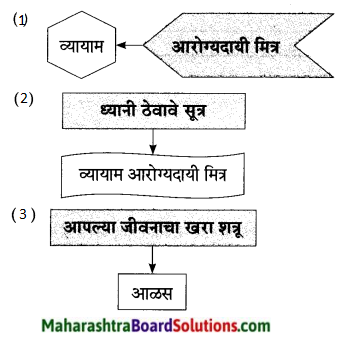
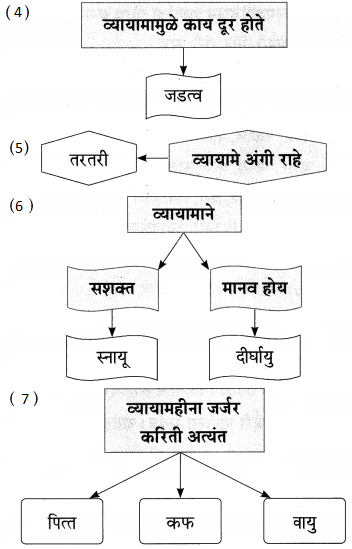
![]()
प्रश्न 2.
उत्तरे लिहा.
उत्तरः
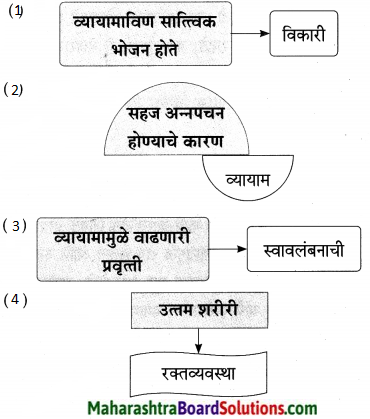
खालील प्रश्नांची उत्तरे एका वाक्यात लिहा.
प्रश्न 1.
सर्वप्रकारे, सर्व ठिकाणी कोणाला वैरी मानावे असे कवी म्हणतो?
उत्तरः
सर्वप्रकारे, सर्व ठिकाणी आळसाला वैरी मानावे असे कवी म्हणतो.
प्रश्न 2.
व्यायामाविण काय विकारी होते असे कवी म्हणतो?
उत्तरः
व्यायामाविण सात्त्विक भोजन विकारी होते असे कवी म्हणतो.
![]()
प्रश्न 3.
व्यायामामुळे शरीरातील रक्तव्यवस्था कशी होते?
उत्तर:
व्यायामामुळे शरीरातील रक्तव्यवस्था उत्तम म्हणजे व्यवस्थित होते.
प्रश्न 4.
व्यायामामुळे माणसाचे आयुष्य कसे होते?
उत्तरः
व्यायामामुळे माणसाचे आयुष्य दीर्घ होते.
कंसातील योग्य शब्द वापरून रिकाम्या जागा भरा.
प्रश्न 1.
- व्यायाम आरोग्यदायी ……………… । हे ध्यानी ठेवावे सूत्र। (सखा, सोबती, मित्र, सवंगडी)
- आळस …………… मानिला सर्वत्र। सर्वतोपरी।। (सखा, दुश्मन, वैरी, सोबती)
- व्यायामाविण सात्त्विक भोजन। तेहि मारी …………… होऊन । (अविकारी, शुद्ध, बदल, विकारी)
- व्यायामे होय अग्निदीपन। ……………. सहजचि।। (अन्नपचन, हवन, शरीरसंपदा, भूक)
- व्यायामे जडत्व जाई दूरी। व्यायामे अंगी राहे …………..। (ताजेपणा, तरतरी, दुबळेपण, आळस)
- व्यायामहीना पित्त, …………,वायु। जर्जर करिती अत्यंत।। (सर्दी, पडसे, ज्वर, कफ)
- व्यायामे वाढे प्रतिकार शक्ति। ……………. प्रवृत्ति। (परावलंबनाची, स्वावलंबनाची, रोगराईची, आजाराची)
उत्तर:
- मित्र
- वैरी
- विकारी
- अन्नपचन
- तरतरी
- कफ
- स्वावलंबनाची
कृती 2 : आकलन कृती
समान अर्थाच्या काव्यपंक्ती शोधून लिहा.
प्रश्न 1.
- व्यायामाअभावी सत्त्वगुणी जेवणही शरीरास उपयोगी नाही.
- आळस हा माणसाचा शत्रू आहे, हे सगळया जगाने मान्य केलेले आहे.
- व्यायामाने शरीरामध्ये तरतरी येते.
- व्यायामाने मानवाचे आयुष्य वाढते.
- व्यायामाने चांगल्या प्रवृत्ती जोपासल्या जातात.
उत्तर:
- व्यायामाविण सात्त्विक भोजन। तेहि मारी विकारी होऊन।।
- आळस वैरी मानिला सर्वत्र। सर्वतोपरी।।
- व्यायामे अंगी राहे तरतरी।
- व्यायामे मानव होय दीर्घायु।
- व्यायाम वाढे प्रतिकार शक्ति। स्वावलंबनाची प्रवृत्ति।
![]()
प्रश्न 2.
जोड्या जुळवा.
| ‘अ’ गट | ‘ब’ गट |
| 1. आरोग्यदायी | (अ) आळस |
| 2. वैरी मानिला | (ब) अन्नपचन |
| 3. सहजचि | (क) सूत्र |
| 4. ध्यानी ठेवावे | (ड) मित्र |
उत्तरः
| ‘अ’ गट | ‘ब’ गट |
| 1. आरोग्यदायी | (ड) मित्र |
| 2. वैरी मानिला | (अ) आळस |
| 3. सहजचि | (ब) अन्नपचन |
| 4. ध्यानी ठेवावे | (क) सूत्र |
प्रश्न 3.
जोड्या जुळवा.
| ‘अ’ गट | ‘ब’ गट |
| 1. जाई दूरी | (अ) सजीवपण |
| 2. वाढे विचारी | (ब) जडत्व |
| 3. अंगी वाढे | (क) दीर्घायु |
| 4. मानव होय | (ड) स्फूर्ति |
उत्तरः
| ‘अ’ गट | ‘ब’ गट |
| 1. जाई दूरी | (ब) जडत्व |
| 2. वाढे विचारी | (अ) सजीवपण |
| 3. अंगी वाढे | (ड) स्फूर्ति |
| 4. मानव होय | (क) दीर्घायु |
प्रश्न 4.
काव्यपंक्तींचा योग्य क्रम लावा.
- व्यायाम आरोग्यदायी मित्र । हे ध्यानी ठेवावे सूत्र।
- व्यायामे होय अग्निदीपन । अन्नपचन सहजचि।।
- आळस वैरी मानिला सर्वत्र। सर्वतोपरी।।
- व्यायामाविण सात्त्विक भोजन। तेहि मारी विकारी होऊन।
- रक्तव्यवस्था उत्तम शरीरी । वाढे विचारी सजीवपण।।
- व्यायामहीना पित्त, कफ, वायु । जर्जर करिती अत्यंत।।
- व्यायामाने सशक्त स्नायु । व्यायामे मानव होय दीर्घायु।
- व्यायामे जडत्त्व जाई दूरी । व्यायामे अंगी राहे तरतरी।
उत्तरः
- व्यायाम आरोग्यदायी मित्र । हे ध्यानी ठेवावे सूत्र।
- आळस वैरी मानिला सर्वत्र। सर्वतोपरी।।
- व्यायामाविण सात्त्विक भोजन। तेहि मारी विकारी होऊन।
- व्यायामे होय अग्निदीपन। अन्नपचन सहजचि।।
- व्यायामे जडत्त्व जाई दूरी । व्यायामे अंगी राहे तरतरी ।
- रक्तव्यवस्था उत्तम शरीरी । वाढे विचारी सजीवपण ।।
- व्यायामाने सशक्त स्नायु । व्यायामे मानव होय दीर्घायु ।
- व्यायामहीना पित्त, कफ, वायु । जर्जर करिती अत्यंत ।।
![]()
प्रश्न 5.
काव्यपंक्तीवरून शब्दांचा योग्य क्रम लावा.
- सर्वतोपरी, मित्र, वैरी, सूत्र
- अग्निदीपन, विकारी, भोजन, अन्नपचन
- सजीवपण, अंगी, उत्तम, तरतरी
- कार्य, प्रवृत्ति, शक्ति, प्रतिकार
- जर्जर, मानव, कफ, सशक्त
उत्तर:
- मित्र, सूत्र, वैरी, सर्वतोपरी
- जन, विकारी, अग्निदीपन, अन्नपचन
- अंगी, तरतरी, उत्तम, सजीवपण
- प्रतिकार, शक्ति, प्रवृत्ति, कार्य .
- सशक्त, मानव, कफ, जर्जर
कृती 3: काव्यसौंदर्य
खालील काव्यपंक्तीतील आशयसौंदर्य स्पष्ट करा.
प्रश्न 1.
आळस वैरी मानिला सर्वत्र। सर्वतोपरी।।
उत्तरः
आळस हा आपल्या जीवनाचा खरा शत्रू आहे, हे सगळ्या जगाने मान्य केलेले आहे. व्यायामामुळेच आळस दूर होऊन शरीर आरोग्यपूर्ण होते.
प्रश्न 2.
व्यायामाविण सात्त्विक भोजन। तेहि मारी विकारी होऊन।
उत्तरः
आरोग्य व्यवस्थित राहावे म्हणून आपण सात्त्विक आहार घेत असतो. या सात्त्विक भोजनाने आपले शरीर व मन छान स्वस्थ राहते; पण तुकडोजी महाराज म्हणतात, की अशा भोजनासोबतच व्यायामही केला पाहिजे. नाहीतर अशा भोजनामुळेही आपणस विविध विकार, विविध आजार होऊ शकतात.
प्रश्न 3.
व्यायामहीना पित्त, कफ, वायु। जर्जर करिती अत्यंत।।
उत्तरः
जर आपण व्यायाम करीत नसू तर आपल्या शरीरात पित्त, कफ, वायू यांचे प्रमाण कमी-जास्त होऊ लागते. पित्त, कफ, वायू यांच्या असंतुलित प्रमाणामुळे रोग होतात आणि आपण आजारी पडतो. त्यामुळे आपल्याला खूप त्रास होतो. व्यायामामुळे पित्त, कफ, वायू यांचे शरीरातील प्रमाण योग्य व संतुलित राहण्यास मदत होते.
प्रश्न 4.
व्यायामे अंगी वाढे स्फूर्ति। कार्य करण्याची।।
उत्तरः
तुकडोजी महाराज म्हणतात, की व्यायामामुळे आपल्या शरीराला बळकटी प्राप्त होऊन रोगप्रतिकारकशक्ती वाढते. येणाऱ्या आजारांचा, संकटांचा आपण सहज सामना करू शकतो. त्याचबरोबर शरीर सुदृढ झाल्यामुळे आपण स्वावलंबीसुद्धा बनतो. आपल्या व्यक्तिगत कामासाठी आपल्याला दुसऱ्या कोणावर अवलंबून राहण्याची आवश्यकता राहत नाही. या नियमित व्यायामामुळे शरीरातील आळस, कंटाळा दूर होऊन ताजेतवाने बनते. शिवाय कोणत्याही कामांमध्येही उत्साह जाणवतो.
![]()
पुढील ओळींचा अर्थ स्पष्ट करा.
प्रश्न 1.
व्यायाम आरोग्यदायी मित्र । हे ध्यानी ठेवावे सूत्र ।
उत्तरः
राष्ट्रसंत श्री तुकडोजी महाराज यांनी आपल्यासारख्या सामान्य माणसांना आपल्या जीवनातील व्यायामाचे महत्त्व साध्या, सरळ भाषेत समजावून सांगितले आहे. ते म्हणतात की, व्यायाम हा आपल्याला सुखाचे आयुष्य देणारा आरोग्यदायी मित्र आहे. हे सूत्र आपण कायम लक्षात ठेवणे गरजेचे आहे.
प्रश्न 2.
व्यायामे जडत्व जाई दूरी । व्यायामे अंगी राहे तरतरी।
उत्तरः
आपण व्यायाम नियमितपणे करायला हवा. योग्य व पुरेसा व्यायाम आपण नियमित केला नाही तर शरीरामध्ये जडत्व म्हणजेच स्थूलपणा वाढत जातो. नियमीत व्यायामामुळे स्थूलपणा कमी होऊन शरीर सुडौल होते. तसेच आळस दूर होऊन अंगामध्ये तरतरी म्हणजेच उत्साह भरतो.
प्रश्न 3.
व्यायामे वाढे प्रतिकार शक्ति । स्वावलंबनाची प्रवृत्ति ।।
उत्तरः
तुकडोजी महाराज म्हणतात की, व्यायामामुळे आपल्या शरीराला बळकटी प्राप्त होऊन रोगप्रतिकारक शक्ती वाढते. येणाऱ्या आजारांचा, संकटांचा आपण सहज सामना करू शकतो. त्याचबरोबर शरीर सुदृढ झाल्यामुळे आपण स्वावलंबीसुद्धा बनतो.
प्रश्न 4.
व्यायामाचे मानवी जीवनातील महत्त्व थोडक्यात सांगा.
उत्तरः
व्यायाम म्हणजे शारीरिक कसरत. व्यायाम फक्त मनुष्याचे शरीरच सुदृढ करीत नाही तर तो व्यक्तीला मनाने देखील बळकट करीत असतो. व्यायाम मन एका ठिकाणी केंद्रित करण्याचे महत्त्वाचे साधन आहे. जर का व्यक्तीचे मन बळकट व स्वस्थ असेल तर ती व्यक्ती शरीराने देखील बळकट होते. व्यायाम काम, क्रोध, वासना, ईर्ष्या, द्वेष, मत्सर व मोह यांपासून मनुष्याचे संरक्षण करतो. माणसाची आत्मिकशक्ती जोपासण्याचे काम व्यायामामुळे शक्य होते. व्यायाम माणसाचे मन, मनगट व मेंदू यांवर समतोल नियंत्रण ठेवतो त्यामुळे व्यक्तीचा व्यक्तिमत्त्व विकास होतो.
प्रश्न 5.
व्यायामाचे शरीराला होणारे फायदे तुमच्या शब्दात लिहा.
उत्तरः
‘आरोग्यम् धनसंपदा’ म्हणजे स्वस्थ शरीर हेच माणसाचे वैभव आहे. सुदृढ आरोग्य माणसाची धनसंपदा आहे. माणसाचे आरोग्य तेव्हाच चांगले व स्वस्थ राहू शकते जेव्हा तो मानसिक व शारीरिकदृष्ट्या बळकट व मजबूत असेल. त्यासाठी नियमितपणे व्यायाम करणे गरजेचे असते. नियमित व्यायाम करणारी व्यक्ती आजारी पडत नाही. ती शरीराने व मनाने नेहमी स्वस्थ राहते. नियमित व्यायाम केल्याने आरोग्य सुदृढ तर राहतेच शिवाय माणूस दीर्घायू होतो. म्हातारपणी सुद्धा माणूस स्वबळावर सर्व शारीरिक क्रिया पार पाडू शकतो. म्हणूनच ‘आरोग्यम् धनसंपदा’ असे जे म्हटले गेलेले आहे ते खरेच आहे.
![]()
प्रश्न 6.
दिलेल्या मुद्द्यांच्या आधारे कवितेसंबंधी पुढील कृती सोडवा.
उत्तरः
1. कवी / कवयित्रीचे नाव – राष्ट्रसंत तुकडोजी महाराज (माणिक बंडोजी ठाकूर)
2. संदर्भ – ‘व्यायामाचे महत्त्व’ ही कविता राष्ट्रसंत तुकडोजी महाराज यांनी लिहिली आहे. ही कविता त्यांच्या ‘ग्रामगीता’ या पुस्तकातून घेतली आहे.
3. प्रस्तावना – ‘व्यायामाचे महत्त्व’ ही कविता राष्ट्रसंत तुकडोजी महाराज यांनी लिहिली आहे. मानवी जीवनातील व्यायामाचे महत्त्व या कवितेतून तुकडोजी महाराजांनी प्रभावीपणे मांडले आहे.
4. वाङमयप्रकार – ‘व्यायामाचे महत्त्व’ ही कविता म्हणजे ‘ओव्या’ आहेत.
5. कवितेचा विषय – व्यायामाचे शरीरावर होणारा सकात्मक परिणाम दर्शविणारी राष्ट्रसंत तुकडोजी महाराज यांची ‘व्यायामाचे महत्त्व’ ही कविता म्हणजे आदर्श ‘ओव्या’ आहेत.
6. कवितेतील आवडलेली ओळ – व्यायामे वाढे प्रतिकार शक्ती । स्वावलंबनाची प्रवृत्ति ।।
व्यायामे अंगी वाढे स्फूर्ति । कार्य करण्याची ।।
7. मध्यवर्ती कल्पना – आरोग्यासाठी व्यायाम अतिशय आवश्यक गोष्ट आहे. व्यायामामुळे शरीरातील रोगप्रतिकारशक्ती वाढते. शिवाय पित्त, कफ, वायू या गोष्टींचे शरीरातील प्रमाण संतुलित राहून शरीर बलवान होते. अशा प्रकारचे मानवी जीवनातील व्यायामाचे महत्त्व दर्शविणारी राष्ट्रसंत तुकडोजी महाराज यांची ‘व्यायामाचे महत्त्व’ ही सुंदर कविता आहे.
8. कवितेतून मिळणारा संदेश – सुदृढ आरोग्य हवे असेल तर व्यायाम करणे आवश्यक आहे. व्यायामामुळे अन्नपचन सहज होते. शिवाय स्थूलपणा कमी होऊन रक्तव्यवस्था उत्तम कार्य करते त्याचबरोबर शरीराचे स्नायू बळकट होऊन रोगप्रतिकार शक्ती वाढते. अंगामधला आळस दूर होऊन स्फूर्ती वाढते. अशाप्रकारे व्यायामामुळे शरीरावर सकारात्मक परिणाम होत असतो म्हणून दररोज व्यायाम करणे आवश्यक आहे. असा संदेश व्यायामाचे महत्त्व’ या कवितेतून आपणास मिळतो.
9. कविता आवडण्याची वा न आवडण्याची कारणे – ‘व्यायामाचे महत्त्व’ ही कविता मला खूप आवडली आहे. याचे महत्त्वाचे कारण म्हणजे आपले आयुष्य उजळून टाकणाऱ्या व्यायामाचे महत्त्व राष्ट्रसंत तुकडोजी महाराजांनी अतिशय सोप्या भाषेत पटवून दिले आहे. त्यांचे शरीरप्रकृतीचे बारीक निरीक्षण मनाला भावणारे आहे.
10. भाषिक वैशिष्ट्ये – ‘व्यायामाचे महत्त्व’ या कवितेमध्ये राष्ट्रसंत तुकडोजी महाराजांनी साध्या आणि सोप्या भाषेचा वापर केला आहे. शिवाय ही कविता ‘ओवी’ रूपात असल्यामुळे प्रत्येक ओवीमध्ये चार चरण दिसून येतात. त्याचबरोबर ‘यमक’ अलंकाराचा वापर शोभून दिसतो.
खालील काव्यपंक्तींचे रसग्रहण करा.
प्रश्न 1.
व्यायाम आरोग्यदायी मित्र। हे ध्यानी ठेवावे सूत्र।
आळस वैरी मानिला सर्वत्र । सर्वतोपरी।।
उत्तरः
‘व्यायामाचे महत्त्व’ ही कविता राष्ट्रसंत श्री तुकडोजी महाराज यांनी लिहिली आहे. मानवी जीवनातील व्यायामाचे महत्त्व या कवितेतून कवीने स्पष्ट केले आहे.
‘राष्ट्रसंत श्री तुकडोजी महाराज’ यांनी आपल्यासारख्या सामान्य माणसांना आपल्या जीवनातील व्यायामाचे महत्त्व साध्या, सरळ भाषेत समजावून सांगितले आहे. ते म्हणतात की, व्यायाम हा आपल्याला सुखाचे आयुष्य देणारा आरोग्यदायी मित्र आहे. हे सूत्र आपण कायम लक्षात ठेवणे गरजेचे आहे. कारण आळस हा आपल्या जीवनाचा खरा शत्रू आहे, हे सगळया जगाने मान्य केलेले आहे. व्यायामामुळेच आळस दूर होऊन शरीर आरोग्यपूर्ण होते.
‘व्यायामाचे महत्त्व’ या कवितेमध्ये राष्ट्रसंत तुकडोजी महाराजांनी साध्या आणि सोप्या भाषेचा वापर केला आहे. शिवाय ही कविता ‘ओवी’ रूपात असल्यामुळे प्रत्येक ओवीमध्ये चार चरण दिसून येतात. त्याचबरोबर ‘यमक’ अलंकाराचा वापर शोभून दिसतो.
![]()
प्रश्न 2.
व्यायामाविण सात्त्विक भोजन। तेहि मारी विकारी होऊन।
व्यायामे होय अग्निदीपन। अन्नपचन सहजचि।।
उत्तरः
‘व्यायामाचे महत्त्व’ ही कविता राष्ट्रसंत श्री तुकडोजी महाराज यांनी लिहिली आहे. मानवी जीवनातील व्यायामाचे महत्त्व या कवितेतून कवीने स्पष्ट केले आहे.
आरोग्य व्यवस्थित राहावे म्हणून आपण सात्त्विक आहार घेत असतो. या सात्त्विक भोजनाने आपले शरीर व मन छान स्वस्थ राहते. पण तुकडोजी महाराज म्हणतात की, अशा भोजनासोबतच व्यायामही केला पाहिजे. नाहीतर अशा भोजनामुळेही आपणास विविध विकार, विविध आजार होऊ शकतात. सात्त्विक भोजनासोबतच चांगला, योग्य व्यायाम केला तर पोटातील जठाराग्नी चांगला प्रदिप्त होतो. म्हणजे पोटातील अग्नी चांगला पेटून आपल्या अन्नाचे सहज पचनही होते. अन्नाचे अपचन होऊन होणारे विकार व्यायामामुळे टाळता येतात.
‘व्यायामाचे महत्त्व’ या कवितेमध्ये राष्ट्रसंत तुकडोजी महाराजांनी साध्या आणि सोप्या भाषेचा वापर केला आहे. शिवाय ही कविता ‘ओवी’ रूपात असल्यामुळे प्रत्येक ओवीमध्ये चार चरण दिसून येतात. त्याचबरोबर ‘यमक’ अलंकाराचा वापर शोभून दिसतो.
प्रश्न 3.
व्यायामे जडत्व जाई दूरी। व्यायामे अंगी राहे तरतरी।
रक्तव्यवस्था उत्तम शरीरी। वाढे विचारी सजीवपण।।
उत्तरः
‘व्यायामाचे महत्त्व’ ही कविता राष्ट्रसंत श्री तुकडोजी महाराज यांनी लिहिली आहे. मानवी जीवनातील व्यायामाचे महत्त्व या कवितेतून कवीने स्पष्ट केले आहे.
आपण व्यायाम नियमितपणे करायला हवा. योग्य व पुरेसा व्यायाम आपण केला नाही तर शरीरामध्ये जडत्व म्हणजेच स्थूलपणा वाढत जातो. नियमित व्यायामामुळे स्थूलपणा कमी होऊन शरीर सुडौल होते. तसेच आळस दूर होऊन अंगामध्ये तरतरी म्हणजेच उत्साह भरतो. तुकडोजी महाराज पुढे म्हणतात की, व्यायामामुळे शरीरातील रक्तव्यवस्था व्यवस्थित होते. रक्तप्रवाह सुरळीत होऊन रक्ताशी संबंधित विकार दूर होतात आणि आपले आयुष्य वाढते.
‘व्यायामाचे महत्त्व’ या कवितेमध्ये राष्ट्रसंत तुकडोजी महाराजांनी साध्या आणि सोप्या भाषेचा वापर केला आहे. शिवाय ही कविता ‘ओवी’ रूपात असल्यामुळे प्रत्येक ओवीमध्ये चार चरण दिसून येतात. त्याचबरोबर ‘यमक’ अलंकाराचा वापर शोभून दिसतो.
प्रश्न 4.
व्यायामे जडत्व जाई दूरी। व्यायामे अंगी राहे तरतरी।
रक्तव्यवस्था उत्तम शरीरी। वाढे विचारी सजीवपण।।
उत्तरः
‘व्यायामाचे महत्त्व’ ही कविता राष्ट्रसंत श्री तुकडोजी महाराज यांनी लिहिली आहे. मानवी जीवनातील व्यायामाचे महत्त्व या कवितेतून कवीने स्पष्ट केले आहे.
आपण व्यायाम नियमितपणे करायला हवा. योग्य व पुरेसा व्यायाम आपण केला नाही तर शरीरामध्ये जडत्व म्हणजेच स्थूलपणा वाढत जातो. नियमित व्यायामामुळे स्थूलपणा कमी होऊन शरीर सुडौल होते. तसेच आळस दूर होऊन अंगामध्ये तरतरी म्हणजेच उत्साह भरतो. तुकडोजी महाराज पुढे म्हणतात की, व्यायामामुळे शरीरातील रक्तव्यवस्था प्रवाही होते. रक्तप्रवाह सुरळीत होऊन रक्ताशी संबंधित विकार दूर होतात आणि आपले आयुष्य वाढते.
‘व्यायामाचे महत्त्व’ या कवितेमध्ये राष्ट्रसंत तुकडोजी महाराजांनी साध्या आणि सोप्या भाषेचा वापर केला आहे. शिवाय ही कविता ‘ओवी’ रूपात असल्यामुळे प्रत्येक ओवीमध्ये चार चरण दिसून येतात. त्याचबरोबर ‘यमक’ अलंकाराचा वापर शोभून दिसतो.
![]()
प्रश्न 5.
व्यायामाने सशक्त स्नायु। व्यायामे मानव होय दीर्घायु।
व्यायामहीना पित्त, कफ, वायु। जर्जर करिती अत्यंत।।
उत्तरः
‘व्यायामाचे महत्त्व’ ही कविता राष्ट्रसंत श्री तुकडोजी महाराज यांनी लिहिली आहे. मानवी जीवनातील व्यायामाचे महत्त्व या कवितेतून कवीने स्पष्ट केले आहे.
नियमित व योग्य व्यायामामुळे आपल्या शरीरातील स्नायूंना बळकटी प्राप्त होते. सगळे स्नायू सशक्त होत जातात. माणसाला आजारपण येत नाही. याच व्यायामामुळे मानवाला दीर्घायुष्य प्राप्त होते, असे तुकडोजी महाराज म्हणतात. आपण जर व्यायाम करीत नसू तर आपल्या शरीरात पित्त, कफ, वायू यांचे प्रमाण कमी-जास्त होऊ लागते. पित्त, कफ, वायू यांच्या असंतुलित प्रमाणामुळे रोग होतात आणि आपण आजारी पडतो. त्यामुळे आपल्याला खूप त्रास होतो. व्यायामामुळे पित्त, कफ, वायू यांचे शरीरातील प्रमाण योग्य व संतुलित राहण्यास मदत होते.
‘व्यायामाचे महत्त्व’ या कवितेमध्ये राष्ट्रसंत तुकडोजी महाराजांनी साध्या आणि सोप्या भाषेचा वापर केला आहे. शिवाय ही कविता ‘ओवी’ रूपात असल्यामुळे प्रत्येक ओवीमध्ये चार चरण दिसून येतात. त्याचबरोबर ‘यमक’ अलंकाराचा वापर शोभून दिसतो.
प्रश्न 6.
व्यायाम वाढे प्रतिकार शक्ति। स्वावलंबनाची प्रवत्ति।
व्यायामे अंगी वाढे स्फूर्ति। कार्य करण्याची।।
उत्तरः
‘व्यायामाचे महत्त्व’ ही कविता राष्ट्रसंत श्री तुकडोजी महाराज यांनी लिहिली आहे. मानवी जीवनातील व्यायामाचे महत्त्व या कवितेतून कवीने स्पष्ट केले आहे.
तुकडोजी महाराज म्हणतात की, व्यायामामुळे आपल्या शरीराला बळकटी प्राप्त होऊन रोग प्रतिकारक शक्ती वाढते. येणाऱ्या आजारांचा, संकटांचा आपण सहज सामना करू शकतो. त्याचबरोबर शरीर सुदृढ झाल्यामुळे आपण स्वावलंबीसुद्धा बनतो. आपल्या व्यक्तिगत कामासाठी आपल्याला दुसऱ्या कोणावर अवलंबून राहण्याची आवश्यकता राहत नाही. या नियमित व्यायामामुळे शरीरातील आळस, कंटाळा दूर होऊन शरीर ताजेतवाने बनते. शिवाय कोणत्याही कामामध्ये उत्साह जाणवतो. म्हणजेच कोणतेही काम करण्याची शरीरातील जोश, स्फूर्ती वाढते.
‘व्यायामाचे महत्त्व’ या कवितेमध्ये राष्ट्रसंत तुकडोजी महाराजांनी साध्या आणि सोप्या भाषेचा वापर केला आहे. शिवाय ही कविता ‘ओवी’ रूपात असल्यामुळे प्रत्येक ओवीमध्ये चार चरण दिसून येतात. त्याचबरोबर ‘यमक’ अलंकाराचा वापर शोभून दिसतो.
व्यायामाचे महत्त Summary in Marathi
कवीचा परिचय:
नाव: राष्ट्रसंत श्री तुकडोजी महाराज ( माणिक बंडोजी ठाकूर)
कालावधी: 1909-1968
संतकवी, समाजसुधारक. अंधश्रद्धा, जातिभेद, धर्मभेद यांसारख्या समाजविघातक गोष्टींवर हल्ले चढवून त्यांनी देशभक्ती, अहिंसा व आत्मसंयम यांचे पाठ दिले. गावागावातून ’गुरुदेव सेवा मंडळे’ स्थापना केली. या कार्याबद्दल जनतेने त्यांना ’राष्ट्रसंत’ ही उपाधी देऊन त्यांचा गौरव केला. त्यांची ‘अनुभवसागर’, ’भजनावली’, ’सेवास्वधर्म’, ’राष्ट्रीय भजनावली’ इत्यादी पुस्तके प्रकाशित आहेत. शिक्षण, भेदाभेद व अस्पृश्यता निर्मूलन, अंधश्रद्धा निर्मूलन, स्वच्छता, सर्वधर्मसमभाव यांविषयी कळकळीचे आवाहन करणारा व अज्ञानी जनतेला वात्सल्ययुक्त भूमिकेतून लोकशिक्षण देणारा त्यांचा ’ग्रामगीता’ हा ग्रंथ खेडोपाडी आदराने वाचला जातो.
![]()
प्रस्तावना:
‘व्यायामाचे महत्त्व’ ही कविता राष्ट्रसंत श्री तुकडोजी महाराज यांनी लिहिली आहे. मानवी जीवनातील व्यायामाचे महत्त्व या कवितेतून कवीने स्पष्ट केले आहे.
Rashtrasant Shri Tukdoji Maharaj has written this poem called ’Vyayamache Mahatva’. The poet has explained the importance of exercise in human life through this poem.
भावार्थ:
व्यायाम आरोग्यदायी …….. सर्वतोपरी ।।
‘राष्ट्रसंत श्री तुकडोजी महाराज’ यांनी आपल्यासारख्या सामान्य माणसांना आपल्या जीवनातील व्यायामाचे महत्त्व साध्या, सरळ भाषेत समजावून सांगितले आहे. ते म्हणतात की, व्यायाम हा आपल्याला सुखाचे आयुष्य देणारा आरोग्यदायी मित्र आहे. हे सूत्र आपण कायम लक्षात ठेवणे गरजेचे आहे. कारण आळस हा आपल्या जीवनाचा खरा शत्रू आहे, हे सगळ्या जगाने मान्य केलेले आहे. व्यायामामुळेच आळस दूर होऊन शरीर आरोग्यपूर्ण होते.
व्यायामाविण सात्त्विक ……. अन्नपचन सहजचि ।।
आरोग्य व्यवस्थित राहावे म्हणून आपण सात्त्विक आहार घेत असतो. या सात्त्विक भोजनाने आपले शरीर व मन छान स्वस्थ राहते. पण तुकडोजी महाराज म्हणतात की, अशा भोजनासोबतच व्यायामही केला पाहिजे, नाहीतर अशा भोजनामुळेही आपणास विविध विकार, विविध आजार होऊ शकतात. सात्त्विक भोजनासोबतच चांगला, योग्य व्यायाम केला तर पोटातील जठाराग्नी चांगला प्रदिप्त होतो. म्हणजे पोटातील अग्नी चांगला पेटून आपल्या अन्नाचे सहज पचनही होते. अन्नाचे अपचन होऊन होणारे विकार व्यायामामुळे टाळता येतात.
व्यायामे जडत्व ……… विचारी सजीवपण ।।
आपण व्यायाम नियमितपणे करायला हवा. योग्य व पुरेसा व्यायाम आपण केला नाही तर शरीरामध्ये जडत्व म्हणजेच स्थूलपणा वाढत जातो. नियमित व्यायामामुळे स्थूलपणा कमी होऊन शरीर सुडौल होते. तसेच आळस दूर होऊन अंगामध्ये तरतरी म्हणजेच उत्साह भरतो. तुकडोजी महाराज पुढे म्हणतात की, व्यायामामुळे शरीरातील रक्तव्यवस्था व्यवस्थित होते. रक्तप्रवाह सुरळीत होऊन रक्ताशी संबंधित विकार दूर होतात आणि आपले आयुष्य वाढते.
व्यायामाने सशक्त स्नायु ……. करिती अत्यंत ।।
नियमित व योग्य व्यायामामुळे आपल्या शरीरातील स्नायूंना बळकटी प्राप्त होते. सगळे स्नायू सशक्त होत जातात. माणसाला आजारपण येत नाही. याच व्यायामामुळे मानवाला दीर्घायुष्य प्राप्त होते, असे तुकडोजी महाराज म्हणतात. आपण जर व्यायाम करीत नसू तर आपल्या शरीरात पित्त, कफ, वायू यांचे प्रमाण कमी-जास्त होऊ लागते. पित्त, कफ, वायू यांच्या असंतुलित प्रमाणामुळे रोग होतात आणि आपण आजारी पडतो. त्यामुळे आपल्याला खूप त्रास होतो. व्यायामामुळे पित्त, कफ, वायू यांचे शरीरातील प्रमाण योग्य व संतुलित राहण्यास मदत होते..
व्यायामे वाढे ……. कार्य करण्याची ।।
तुकडोजी महाराज म्हणतात की, व्यायामामुळे आपल्या शरीराला बळकटी प्राप्त होऊन रोग प्रतिकारक शक्ती वाढते. येणाऱ्या आजारांचा, संकटांचा आपण सहज सामना करू शकतो. त्याचबरोबर शरीर सुदृढ झाल्यामुळे आपण स्वावलंबीसुद्धा बनतो. आपल्या व्यक्तिगत कामासाठी आपल्याला दुसऱ्या कोणावर अवलंबून राहण्याची आवश्यकता राहत नाही. या नियमित व्यायामामुळे शरीरातील आळस, कंटाळा दूर होऊन शरीर ताजेतवाने बनते. शिवाय कोणत्याही कामामध्ये उत्साह जाणवतो. म्हणजेच कोणतेही काम करण्याची शरीरातील जोश, स्फूर्ती वाढते.
![]()
शब्दार्थ:
- अपघात – दुर्घटना (an accident)
- व्यायाम – कसरत, कवायत, शारीरिक मेहनत देणारी क्रिया (Physical exercise)
- महत्त्व – मोल (importance)
- उपाधी – पदवी (a title)
- गौरव – मानसन्मान, सन्मान (honour, respect)
- आरोग्य – स्वास्थ्य (health)
- ध्यानी – (येथे अर्थ) लक्षात, मनात (in mind)
- सूत्र – पद्धत, रीत (formula, key)
- आळस – सुस्ती (laziness)
- वैरी – शत्रू (an enemy)
- मानिला – मानला (considered, regarded)
- विण – (येथे अर्थ) शिवाय (without)
- सात्त्विक – पवित्र, शुद्ध (holy, pure)
- भोजन – जेवण (food, meals)
- विकारी – (येथे अर्थ) आजारी (sick, ill, ailing)
- दीपन – पेटणे, ज्वलन
- अन्न – खादयपदार्थ (food)
- पचन – जिरण्याची क्रिया (digestion)
- जडत्व – जडता, जडपणा, स्थूलपणा (heaviness)
- अंग – शरीर (body)
- तरतरी – (येथे अर्थ) चपळाई, चलाखी, उत्साह (sharpness, smartness, freshness)
- रक्त – रुधिर (blood)
- उत्तम – अत्यंत चांगले, उत्कृष्ट (best, excellent)
- शरीर – काया, देह (body)
- सजीव – जिवंत (living, organic)
- सशक्त – मजबूत, ताकदवान (strong, powerful)
- स्नायू – (muscle)
- मानव – मनुष्य (human)
- दीर्घायु – प्रदीर्घ जीवन (a long life)
- पित्त – अन्नपचनास मदत करणारा एक पिवळा द्रव, एक शरीर दोष (bile)
- जर्जर – (येथे अर्थ) त्रस्त, पीडित
- प्रतिकार शक्ती – विरोध करणारी ताकद (resistance power)
- स्वावलंबन – आत्मावलंबन (self-dependence)
- प्रवृत्ति – कल (tendency)
- स्फूर्ति – प्रेरक शक्ती (inspiration)
- कार्य – कृती, काम, क्रिया (an act, work)






